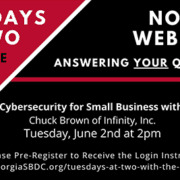
Spring Cleaning Your Digital House
Isn’t it such a relief when things are clean? A fresh-smelling kitchen, tidy living room, organized office. Doesn’t it make you feel like you can do your best work and be your best self?
I think that’s the real reason we keep the spring cleaning tradition. We know it might be a lot of work for a few days, but the end result is just… AHHHHHHHH.
So let’s continue that feeling of peace and control and spring clean our digital lives, too. Because honestly, we do a lot of ‘online living’ nowadays. Social media accounts, banking, shopping, entertainment—the list goes on and on. And while it’s easier to ignore our data and devices, it’s a mistake. And it can be very costly if we’re not careful.
How to Spring Clean Your Devices and Accounts
Be warned: this is going to take time. Especially if you’ve never done some of the recommended digital spring cleaning activities before, you’re going to want to break them into pieces and work through them a little bit at a time. Sometimes starting with the simplest or quickest tasks can give you a ‘win’ to be happy about and build on.
- Literally clean your devices. Don’t dunk them in soapy water or anything, but clean your screens, keyboards, mouse, cases, etc. Dust them off at least, and consider wiping them down with cleaning alcohol (at least 70%).
- Back up your data. Whether it’s to the cloud or an external hard drive, storing a separate copy of your data and backing it up periodically can save you headaches and heartaches. From important documents to priceless family photos, backups can save you time, preserve precious memories, and give you peace of mind. And unless it’s the first time you’re backing up and you have decades’ worth of information, it’s usually done in minutes.
- Check for software updates. Unless your phone, computer, and any other Internet of Things-connected devices are set to update automatically, it’s time to see what bug fixes or vulnerabilities can be addressed.
- Close old email or website accounts. Look at the apps on your phone that you haven’t used in months. Close those accounts and remove the apps. (If you remove the app without closing your account, your data will still be out there.) You can also run your email through haveibeenpwned.com to see what accounts are out there that you may have forgotten about, as well as getting info about breaches your data may have been involved in.
- Unsubscribe to email lists you no longer want. Sure it’s easy to just delete them, but why bother dealing with them at all? Keep in mind unsubscribing is not the same thing as reaching out to a company and telling them to delete your account and contact information, but it’s a quick way to get fewer emails. And getting fewer emails can not only free up some of your time, but can help you notice the sneaky phishing ones better.
- Review your privacy settings. This one sounds simple but can mean going into a lot of different programs. You’ll want to check the settings on your phone and turn off automatic data sharing or tracking that you don’t need to have on. Then you’ll want to do the same thing for all your social media accounts and any apps you have. Remember to check for permission to access your camera, microphone, photos, and contact lists. Many apps ask for this initially and we agree without thinking, even if it’s not at all necessary to use the app. The good thing about this step is that after you do it once, it shouldn’t change without your permission, so it’s easy to stay on top of and just check once a year or so.
- Enable MFA on every account that offers it. We stress this recommendation all the time. It is the simplest and most effective method of protecting your data. It usually adds a couple of seconds or an extra click to logging in, but it’s free and absolutely worth the added security.
- Update your passwords on any accounts you keep active. A recent statistic said most U.S. adults have an average of 240 different accounts or logins. 😲 And for those not using a password manager, we KNOW you’re not setting long, strong, unique passwords for every account. How do we know this? Because there are still breaches in the news every single day that trace back to improperly configured credentials.
- Wipe any old devices you plan to re-sell, donate, or trash. If you come across that first flip phone you loved while you’re physically spring cleaning, you should wipe it clean (of your data) before giving it a new home…even if that home is the trash. Remove any SIM cards and do a factory reset so you never have to worry about it again. If you come across any old work devices, talk to your manager or IT partner about properly disposing of it.
As pointed out above, taking care of all of these recommendations will be time-consuming. But pretty much just the first time. Ongoing checks and maintenance will be quick and easy, and you’ll sleep better in your freshly cleaned home knowing your digital house is in order as well.
For more tips on protecting your online self, click on the tags below for related blogs – data privacy in particular.











